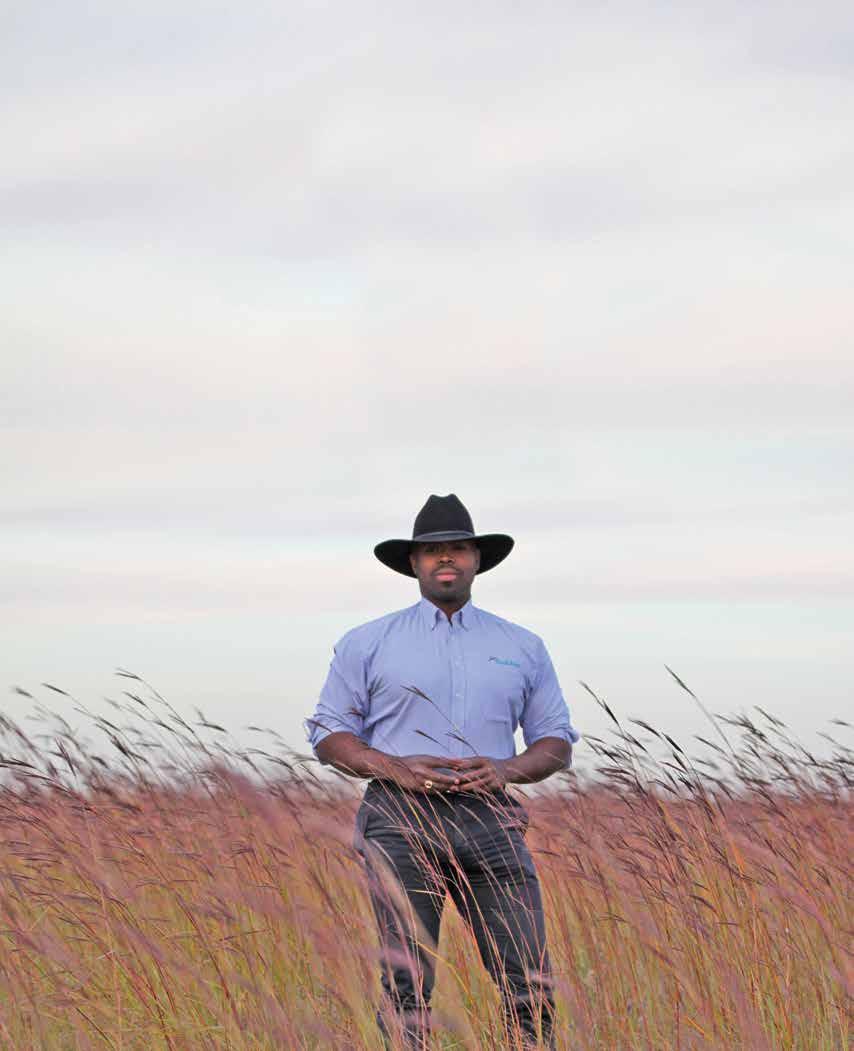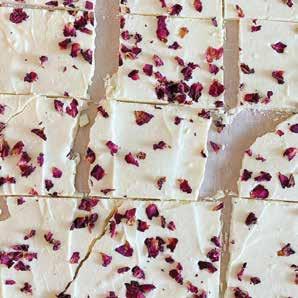
13 minute read
From Edible Communities
EAT. DRINK. THINK.
How we inhabit this planet and envision its future is more critical now than at any time in our history. is past year has certainly taught us that—it has exposed our vulnerabilities, our frail insigni cance in the scheme of things. Yet during this turbulent and challenging time we have also found hope.
Advertisement
On the following pages, we bring you the rst in a series of thought leadership stories that span topics on sustainability, hunger, restaurant revitalization and regenerative agriculture. ese are the values that Edible Communities, as an organization, has been devoted to for the past two decades. Our work lends itself to the singular notion that excellent storytelling has the power to change lives; and that by exploring and elevating important conversations like these, we can create massive change.
We also know that change is impossible without the support of our readers —consumers who have the power to reshape the world we live in. Every farmer, rancher, entrepreneur and organization we champion is better o because of you. You read, learn, take action and vote with your forks. It will be you who ultimately tilts the scale toward a more sustainable future, a more sustainable food system. ank you for joining us as we collectively set our sights on creating a future that is nothing less than extraordinary. One that binds the ecosystems of our lives to Mother Nature without a disconnect between what is on our plates and where it comes from—where all of the seemingly smaller choices we make today add up to massive, beautiful and everlasting positive change.
Tracey Ryder Co-Founder, Edible Communities
Marshall Johnson, Vice President of Conservation Ranching for Audubon standing in a eld of prairie grass.
Photo courtesy of Audubon
Words Bill and Katie Delaney Photos Jesse Brantman
THE BIRDS & THE BEEF
WORDS BY Joy Manning + PHOTOS BY Candice Vivien
You’ve seen the headlines: Beef is destroying the planet. You’ve heard all about the greenhouse gases and pollution a typical beef operation produces. But the idea that beef is an environmental disaster isn’t quite that simple. ose dire warnings are based on one kind of beef: e conventional, factory-farmed kind. And it is, by far, the most commonly consumed beef in North America. In fact, 97% of the beef in the US food supply is grain-fed, feedlot beef.
But there’s another way to produce beef, a way that actually enriches the environment. And it’s happening across at least 3.5 million acres of American grassland. Kay Cornelius, a fourth-generation rancher and new general manager at Panorama Meats, intends to add another million acres to that total by 2030 through a groundbreaking new partnership with an unlikely ally: e National Audubon Society.
A NEW SEAL OF APPROVAL
“All of our data proves that grassland birds are the most imperiled group of bird species in America. Grassland birds have lost 53% of their population since 1970, and 95% of all grassland birds live on cattle ranches,” says Marshall Johnson, vicepresident of Audubon’s conservation ranching initiative. e nonpro t’s “Grazed on Audubon Certi ed Bird-friendly Land” seal was established to recognize ranches that are managed in a way that protects those birds. Saving these birds is a vital part of maintaining biodiversity. Like bees, birds are important pollinators, and they help maintain the delicate balance of a grassland ecosystem. rough Audubon’s new partnership with Panorama, every ranch in Panorama’s network will earn that Grazed on Audubon Certi ed Bird-friendly Land seal. “We began the project of introducing this certi cation in 2013, and we enrolled our rst ranch in 2017,” says Johnson. Joining forces with Panorama now means adding 1 million acres of land to the 2.5 million acres that have already been certi ed as bird-friendly. “It means a lot to partner with an organization that has built its brand in alignment with our core values,” says Johnson.
Darrell Wood, founding Panorama rancher, was the rst in the network to get certi ed. “I volunteered. I wanted to see how it went and what the level of di culty would be for ranchers,” he says. And he discovered the bene ts greatly outweighed any extra e ort. In large part, the certi cation is an acknowledgement of what Panorama ranches, all of which were already organic, have been doing for years.
As part of the program, each ranch gets an annual visit from a rangeland biologist who takes soil samples, measures the vegetation, and assesses how the ranch a ects bird life. en Audubon creates a habitat management plan for the rancher with suggestions for improvements. “ e ranches enrolled are going to become even more bird friendly, but they were already doing great things,” says Johnson.
FARMERS FIRST
Cornelius isn’t new to dramatically growing a network of environmentally friendly farmers. Before taking the helm of Panorama Meats as general manager last September, she doubled sales in her role as vice president for the biggest and bestknown name in humanely raised meats, Niman Ranch. “I spent 12 years there working for farmers, and in my new job I’m still helping farmers earn a living,” she says.
Finding ways to grow and protect a rancher’s livelihood is a high priority for Cornelius personally and central to Panorama Meats’ mission. “I grew up in a rural community during the farm crisis years. My mom and dad really struggled,” she says. e experience of watching her once-thriving farming community dry up back then informs everything she does today. “At Niman
Ranch, we really celebrated the family farmer doing the right thing and we’re doing the same thing at Panorama.” e simplest way to keep these family farms in business is to ensure they are able to get their product to market and to be paid a fair price. Being part of Panorama’s network helps them accomplish these goals, and the Audubon’s bird-friendly seal provides a major boost, a way to make these special packages of meat stand out from everything else in the butcher’s case for environmental conscious consumers.
SAVING GRASSLAND e connection between beef, birds, grassland, and climate change isn’t immediately obvious. To understand how a properly managed ranch can actually help remove carbon from the atmosphere, you have to understand the long history of North America’s grassland.
Before they were hunted nearly to extinction in the late 19th century, wild bison grazed an area just the right amount to promote the growth of a complex and robust root system without killing the plants. Domestic cows, if left to their own devices, will eat the grass down to the bare earth, destroying the grassland. To make them more like their ancestors, ranchers must use rotational grazing, moving them from spot to spot to achieve that ideal level of grazing. “Cattle can mimic what historic bison used to do. at’s why we need them,” says Johnson.

Red-winged blackbird
Continued...
4 Ways to Shop for Sustainable Meat
Not every supermarket is stocked with grass-fed, grass-finished and bird-friendly beef—yet. If you can’t find it at your store, there are still ways to purchase sustainable steaks, chops, and burgers wherever you are. Here are some tips to get you started.
1. SHOP ONLINE
Panorama has partnered with online retailer CrowdCow.com and you can nd their beef as well as meat from other high-quality sustainable ranchers there.
2. BUY A COW SHARE
In many communities, smaller farmers and ranchers will sell onehalf, one-quarter, or one-eighth of a single animal to you. Check out
EatWild.com to nd one near you.
3. SHOP AT YOUR
FARMERS MARKET
Farmers markets are typically a great place to connect with the kind of farmers and ranchers who are passionate about sustainability and land stewardship.
4. ASK QUESTIONS
When you’re shopping, ask your butcher where the beef comes from and how it was raised. is educates you and lets them know there’s a demand for sustainable beef.




Without animals grazing, grassland becomes overwhelmed with weeds and invasive plant species. e soil quality is degraded, and animal life, birds and pollinators like bees lose their habitat. Vernal pools dry up and disappear. Without well-managed grassland, some species can even become extinct. “ ere’s a vernal pool on my ranch that hosts an endangered species called fairy shrimp,” says Wood. “I have a stream that goes through my property that’s one of the major salmon spawning streams in California.”
And then there’s the matter of carbon. It’s true that cows emit carbon into the atmosphere, about 80 tons annually for a ranch of 150 acres, according to the Texas Department of Agriculture. ere’s also a certain amount of carbon emissions associated with the farm equipment (32 tons). But well-managed grassland, with its deep root systems, lush vegetation, and rich soil, is actually able to remove 500 tons of carbon from the atmosphere per year, giving it an overall positive e ect on the environment rather than a negative one. It should be noted that this only applies to cattle ranches with high standards for land management and environmental stewardship--not conventional factory farms.
Raising beef cattle on pasture this way does take longer: Cows don’t fatten up as quickly without the grains provided by feedlots, and they expend more energy grazing than on a feedlot. It also requires more space. As a result, a rancher practicing this kind of regenerative agriculture cannot produce the same volume of beef on the same acreage as a factory farm. eir beef must therefore be sold at a premium. e preservation of this land is important to everyone, but these eco-minded ranchers can only protect the grassland, the birds, and the whole ecosystem it supports if they can earn a living doing it. at’s where you come in.
A MARKET SOLUTION e way Kay Cornelius sees it, people are looking for three things when they’re shopping for grass-fed beef. “ ey want to know it’s organic, they want to know that the animals were treated humanely, and they want to know about the environmental impact,” she says. “With the USDA organic seal and the Step 4 animal welfare standards, we had the rst two covered.” But until this new partnership with Audubon, Panorama had no iron-clad way to convey their commitment to the environment in a way easily understood by busy shoppers. e Grazed on Audubon Certi ed Bird-friendly Land seal requires third-party certi cation. Audubon is one of the most trusted names in conservation. is means, in an era of spurious label claims, the Audubon seal stands out as meaningful. According to Johnson, since the rst ranches were enrolled in the program in 2016, bird abundance has increased on those grasslands by 36%. is is a good indication that other species, especially bees and other pollinators necessary for the food supply, are ourishing as well.
“Consumers buy grass-fed beef to vote for a change in the environment. Paying a little more for beef is a nudge in the right direction,” says Cornelius. It’s a small price to pay for doing your part to preserve America’s grassland and the birds that call it home. e
Darrell Wood and Kay Cornelius of Panorama Organic


Garden Party
Magnolia’s Yarden
Story by Rachel Trigueiro | Photos by Salina Marroquin
ANIELLE FISCH DESIGNER, GROWER and owner of
Magnolia’s Yarden, is on a mission to inspire people to cultivate a botanical lifestyle. Her heart beats for cultivating plants, and more specifically, plants that have a purpose. “I am really passionate about growing plants that provide food.” This mantra might sound common in the Central Valley, but Magnolia’s Yarden isn’t full of stone fruits or nut trees. Her garden is filled of roses, daisies, hollyhocks, primrose, snapdragons, zinnias and more. Whilst lavender and pansies are commonly known edible flowers, most people do not grow flowers in their garden to eat them. Fischer hopes to change that. After years of focused environmental work, sustainability and teaching kids about composting, she says, “I dove into the world of edible flowers and experimenting, flavors, beauty and presentation,” which began her botanical journey six years ago in Clovis. “Plants have always been a part of my life,” she says. And it’s clear; Fischer’s joy in discussing botanicals in food is palpable. Magnolia’s Yarden is reshaping the way one sees beauty in a flower. It’s not just the color and aroma; it’s the health benefits and tastes that no other plant can offer.
One of Fischer’s favorite flowers to cook with is the classic English Rose in a white chocolate bark. For those who enjoy cooking, Fischer recommends nasturtium, the cheerful trumpet-like flower. “Spring rolls are a great place to start for incorporating botanicals into a savory dish. Cheese, charcuterie boards and baked goods are also beautiful places to mix in edible flowers,” she says.
Depending on what’s in season, fresh, dried or pressed flowers can be purchased online, while locals can taste her floral harvest around the Fresno Restaurant scene. At the start of the year, Magnolia’s Yarden joined Ampersand Ice Cream to collaborate on monthly-featured flavors. February’s Vanilla Lavender was such a hit it’s now on the menu. April’s flavor was Honey Rose Pistachio, but the professional plant lady is not giving away any secrets on what’s next. You’ll have to visit Ampersand to see the newest monthly flavor.




Edible flowers can also be found in cocktails at both Quail State Rooftop bar and Modernist Craft Cocktail bar, as well as on the renowned Fig & Honey’s delectable boards and tables.
In addition to growing edible flowers, Magnolia’s Yarden helps people in their own backyard with plant design. Depending on a person’s goals, the Magnolia team provides onsite consultation, design and care tips for anything from edible gardens to Zen gardens, rose gardens or just backyard face-lifts for a party.
Garden parties and private workshops are another option at Magnolia’s Yarden. Think of the trendy wine and paint nights, but instead of crafting in a business or warehouse, the party comes to you. The team brings their DIY goods – like succulent terrariums – to a host’s party, and attendees, sip, snack and craft their own beautiful creation. Garden parties are intimate and charming, making it a wonderful and memorable option in 2021.
“The majority of people who have gotten into plants this last season of being home have really reaped the therapeutic benefits of plants,” she says. “Gardening and putzing outside with plants is so therapeutic for everyone. I love to inspire people with plants and florals because they make people so happy!” And don’t we all need just a little more happy? •
magnoliasyarden.com Find them on Facebook and Instagram








